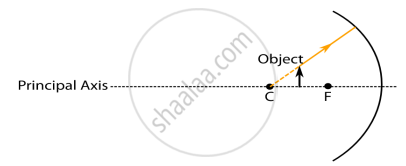Advertisements
Advertisements
प्रश्न
Which type of mirror is used in the following?
Floodlights
उत्तर
Concave mirror
APPEARS IN
संबंधित प्रश्न
Consider the following diagram in which M is a mirror and P is an object and Q is its magnified image formed by the mirror.

State the type of the mirror M and one characteristic property of the image Q.
List four characteristics of the images formed by plane mirrors.
To construct a ray diagram we use two rays of light which are so chosen that it is easy to determine their directions after reflection from the mirror. Choose these two rays and state the path of these rays after reflection from a concave mirror. Use these two rays to find the nature and position of the image of an object placed at a distance of 15 cm from a concave mirror of focal length 10 cm.
The image formed by a concave mirror is observed to be virtual, erect and larger than the object. Where should the position of the object be relative to the mirror? Draw ray diagram to justify your answer.
Name the mirror that can give an erect and enlarged image of an object.
The image formed by a concave mirror is observed to be virtual, erect and larger than the object. Where should be the position of the object?
With the help of a ray diagram, determine the position, nature and size of the image formed of an object placed at the centre of curvature of a concave mirror.
What is the position of the image when an object is placed at a distance of 20 cm from a concave mirror of focal length 20 cm?
Write down a formula for the magnification produced by a concave mirror.
in terms of height of object and height of image
A large concave mirror has a radius of curvature of 1.5 m. A person stands 10 m in front of the mirror. Where is the person's image?
An object is 24 cm away from a concave mirror and its image is 16 cm from the mirror. Find the focal length and radius of curvature of the mirror, and the magnification of the image.
At what distance from a concave mirror of focal length 10 cm should an object be placed so that:
its real image is formed 20 cm from the mirror?
Draw a ray diagram to show the formation of image of an object placed between the pole and focus of a concave mirror. State the position, size and nature of the image.
How can a concave mirror be used to obtain a virtual image of an object? Draw a diagram to illustrate your answer.
A student obtained a sharp inverted image of a distant tree on a screen placed in front of the concave mirror. He then removed the screen and tried to look into the mirror. He would now see
(A) a very blurred image on the wall opposite to the mirror
(B) an erect and magnified image of the tree in the mirror
(C) no image as the screen has been removed
(D) a highly diminished inverted image of the tree at the focus of the mirror.
A _____________ mirror is used by a dentist.
In which of the following, the image of an object placed at infinity will be highly diminished and point sized?

While looking at the above diagram, Nalini concluded the following.
- the image of the object will be a virtual one.
- the reflected ray will travel along the same path as the incident ray but in opposite direction.
- the image of the object will be inverted.
- this is a concave mirror and hence the focal length will be negative.
Which one of the above statements are correct?
______ mirrors magnify the object placed close to them.
